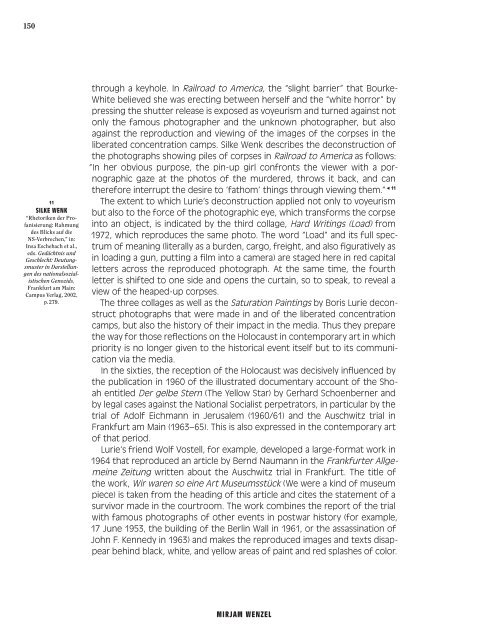The Art of
Katalog_Boris-Lurie_English
Katalog_Boris-Lurie_English
Create successful ePaper yourself
Turn your PDF publications into a flip-book with our unique Google optimized e-Paper software.
150<br />
11<br />
SILKE WENK<br />
“Rhetoriken der Pr<strong>of</strong>anisierung:<br />
Rahmung<br />
des Blicks auf die<br />
NS-Verbrechen,” in:<br />
Insa Eschebach et al.,<br />
eds. Gedächtnis und<br />
Geschlecht: Deutungsmuster<br />
in Darstellungen<br />
des nationalsozialistischen<br />
Genozids,<br />
Frankfurt am Main:<br />
Campus Verlag, 2002,<br />
p. 279.<br />
through a keyhole. In Railroad to America, the “slight barrier” that Bourke-<br />
White believed she was erecting between herself and the “white horror” by<br />
pressing the shutter release is exposed as voyeurism and turned against not<br />
only the famous photographer and the unknown photographer, but also<br />
against the reproduction and viewing <strong>of</strong> the images <strong>of</strong> the corpses in the<br />
liberated concentration camps. Silke Wenk describes the deconstruction <strong>of</strong><br />
the photographs showing piles <strong>of</strong> corpses in Railroad to America as follows:<br />
“In her obvious purpose, the pin-up girl confronts the viewer with a pornographic<br />
gaze at the photos <strong>of</strong> the murdered, throws it back, and can<br />
therefore interrupt the desire to ‘fathom’ things through viewing them.” 11<br />
<strong>The</strong> extent to which Lurie‘s deconstruction applied not only to voyeurism<br />
but also to the force <strong>of</strong> the photographic eye, which transforms the corpse<br />
into an object, is indicated by the third collage, Hard Writings (Load) from<br />
1972, which reproduces the same photo. <strong>The</strong> word “Load” and its full spectrum<br />
<strong>of</strong> meaning (literally as a burden, cargo, freight, and also figuratively as<br />
in loading a gun, putting a film into a camera) are staged here in red capital<br />
letters across the reproduced photograph. At the same time, the fourth<br />
letter is shifted to one side and opens the curtain, so to speak, to reveal a<br />
view <strong>of</strong> the heaped-up corpses.<br />
<strong>The</strong> three collages as well as the Saturation Paintings by Boris Lurie deconstruct<br />
photographs that were made in and <strong>of</strong> the liberated concentration<br />
camps, but also the history <strong>of</strong> their impact in the media. Thus they prepare<br />
the way for those reflections on the Holocaust in contemporary art in which<br />
priority is no longer given to the historical event itself but to its communication<br />
via the media.<br />
In the sixties, the reception <strong>of</strong> the Holocaust was decisively influenced by<br />
the publication in 1960 <strong>of</strong> the illustrated documentary account <strong>of</strong> the Shoah<br />
entitled Der gelbe Stern (<strong>The</strong> Yellow Star) by Gerhard Schoenberner and<br />
by legal cases against the National Socialist perpetrators, in particular by the<br />
trial <strong>of</strong> Adolf Eichmann in Jerusalem (1960/61) and the Auschwitz trial in<br />
Frankfurt am Main (1963–65). This is also expressed in the contemporary art<br />
<strong>of</strong> that period.<br />
Lurie‘s friend Wolf Vostell, for example, developed a large-format work in<br />
1964 that reproduced an article by Bernd Naumann in the Frankfurter Allgemeine<br />
Zeitung written about the Auschwitz trial in Frankfurt. <strong>The</strong> title <strong>of</strong><br />
the work, Wir waren so eine <strong>Art</strong> Museumsstück (We were a kind <strong>of</strong> museum<br />
piece) is taken from the heading <strong>of</strong> this article and cites the statement <strong>of</strong> a<br />
survivor made in the courtroom. <strong>The</strong> work combines the report <strong>of</strong> the trial<br />
with famous photographs <strong>of</strong> other events in postwar history (for example,<br />
17 June 1953, the building <strong>of</strong> the Berlin Wall in 1961, or the assassination <strong>of</strong><br />
John F. Kennedy in 1963) and makes the reproduced images and texts disappear<br />
behind black, white, and yellow areas <strong>of</strong> paint and red splashes <strong>of</strong> color.<br />
MIRJAM WENZEL



